|
WUDANG
武 當 : SWORD, SOLO AND TWO-MAN SETS.
Note: to correctly visualize the Chinese characters, it is necessary to use the
font Arial Unicode MS. Almost all the modern versions of Windows possess it.
Here are only reported the most important characters. For a complete
listing see the Italian version.
.
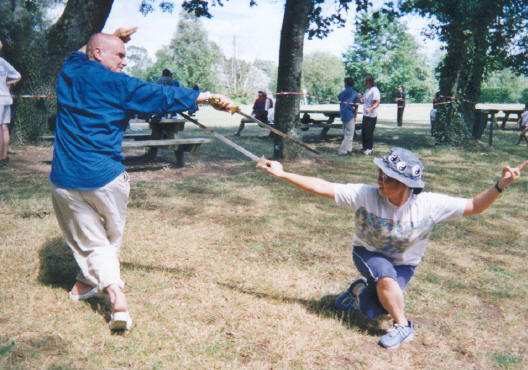
The Wudang tradition is famous, in China, as
well as for Taiji, Bagua, Xingyi and innumerable smaller arts, for the
sword techniques . The forms of Wudang sword are innumerable, I have
learned a certain number of them, but while the apprentices are almost
everywhere found to have to do sooner or later with a form of solo sword,
few of them have practised the forms of two-man sword . I have practised
Wudang sword with various teachers among whom Pei Wujun of Shanghai ( Pei
Xirong's son) and Fu Meilan and Fu Wenlong of Guangzhou (not to quote then other
forms of Taiji sword or the form of bagua sword of Liu Jingru).
Recently (end July 2003) I have had the pleasure to teach the first of
five forms of sword two man set at Rencontres Jasnieres, in France, near Marçon
(next to Chateau du Loire), a place where every year happens an international
festival of Taiji and similar arts. I say 'to like' because it has been pleasant
indeed and because personally I am impassioned with wudang sword. I have taught
first the single techniques and their use as an introduction, then in the first
form we have united together them in the same form. This is according my
thinking the correct way to teach: before the techniques and their use and only after the form.
In two days the students that participated have been able to learn so the whole
form in a way, we can say, acceptable. Here under some sequences of the
two-man form.
|
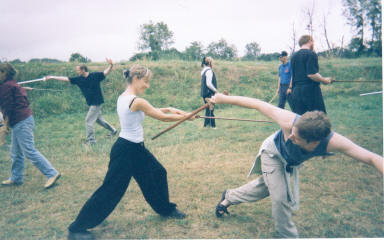 |
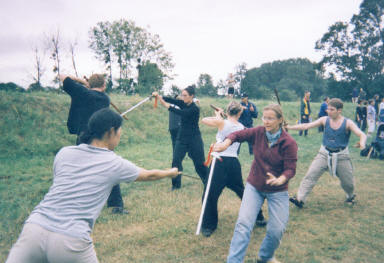 |
|
Jasnieres ,luglio 2003.
2-man set:1
-Fan beng-jian versus ci-jian |
2 - Fan-ge / Dai-yao (to attack
the wrist
to cut the waist) |
|
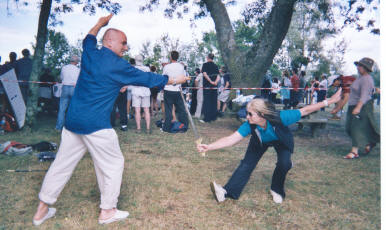 |
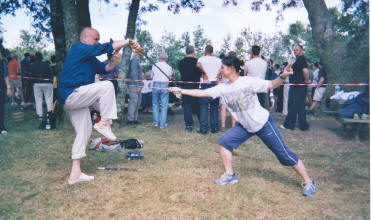 |
|
3 / Loriano attacks
using Ji-jian to the temple;
low defense, beng-jian. |
4 / Defense (jie-jian)
versus direct attack |
|
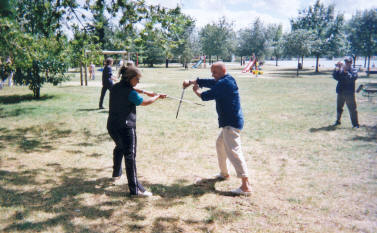 |
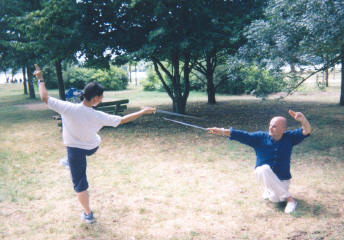 |
|
5 / Fan-ge/dai-yao
moving around (final set) |
6 / Conclusion : Unicorno
looks at the moon
(bagua sword) versus xiebu-fanbeng. |
ORIGINS OF THE WUDANG SWORD .
The wudang sword is credited to go back , as the other wudang forms,
to Zhang Sanfeng (so already Wu Junshan in 1932, in his book Wudang jian pu
). Sanfeng would have handed down it to the famous Zhang Songxi 張 松 溪,
Daoist founder of the Zhang Songxi neijia quan "the internal boxing of
Zhang Songxi"; he was a man of Dengfeng xian district in Henan that then
lived on the Simingshan mountain in Zhejiang area; for this,
his sword forms also took the name of siming jian . He is credited
as the first generation. The second generation is constituted by Zhao
Dabin that originated from Shandong and resided on the sacred
mountain Taishan . The third generation was formed by Wang Jiucheng that
lived on the Wudangshan. To the fourth grade we find Yan Xisheng, a man of
Hengshan xian in Hubei... and so on as long as to the eighth generation when we
find Ma Yuncheng that received the tradition from Chen Mengchang of the
seventh generation. Ma Yuncheng came from Hebei, in the North,
Quyang district and passed down the tradition to
Song Weiyi
宋 唯 一 (alias Dehou). Song Weiyi started at first to teach Zhang Xiangwu and then Li
Fangchen (more known as Li Jinglin李
景 林) and Jiang Xinshan ; these men
were to create or to systematize the techniques of wudang sword as
we know today.
Li Jinglin, after having studied as a young the Confucianism (Ruism) and being
therefore a literate, studied then the martial arts from his father .
After this, he started to travel and learned the art of the sword
from the expert of wudang sword Chen Shijun. Subsequently he learned the
Taijiquan and the Shuaijiao in which became excellent; he undertake
therefore the military career becoming general and he created a body of
one hundred martial artists with the heading of the Baguazhang master Fu Zhensong
傅 振 嵩 and with assistants Na Chaoqing , Wang Puyu , Chen Puzhong and Song
Jinlan . These men practiced the whole day; in the evening Li Jinglin
would them gathered and brought them to practice the shuaijiao techniques, the
striking techniques, qinna (capturing skills) and
swordmanship. In 1928 the Nanjing Central institute of Guoshu was founded (=
National Art = Kungfu) and
Zhang Zhijiang 張 之
江 was named president. He
sent to Beijing the appointee, Luo Bin to choose the most famous teachers
of Martial Arts. To improve the sword techniques were called the
Baguazhang teacher
Jia Fengming 賈 風 鳴 that had been in precedence the first
teacher of Fu Zhensong and also the Bagua teacher of Tianjin, Jiang Laosan
. Fu Zhensong, together with his collaborators, designated
Zhang Dejun
張 德 君 and Guo Qifeng
郭 歧風 to effect sword duels to be able to study them and to
systematize their techniques. The two teachers, using bamboo swords,
performed their sword techniques and on this base the two-man sets were
built (duijian) in wich were embodied the 13 principals techniques of
wudang sword. The duijians so constituted were five (the first one is that
of which the photos are seen here above).
Li Jinglin had been named vice-president of the Central institute of Guoshu of
Nanjing but he often traveled, for es. to Tianjin and he often resided to
Hangzhou. In all these moves he publicized the techniques of wudang sword
and therefore the students of this art were numerous more and more. Some famous
students of his were Huang Yuanxiu and Zhu Guiting . At the 1936 Berlin
Olympiads the wudang sword-techniques were shown that got so one some
resonance also in the foreign countries.
Guo Qifeng, called "the sword-immortal one " , at the end of the
years '40 traveled in a lot of places of China becoming famous and teaching to
numerous groups in Shenyang, Beiping, Shandong, Yangzhou , Changsha, Wuhan and
Guangzhou . Only in Changsha and Wuhan, he for example, taught
famous martial artists as Li Ciyi , Cao Zhongsheng , Liu Chunchen, Liang Xudong
and others. Guo Qifeng in late age published 13 Chapters on the sword.
Other propagators in following ages were Li Tianji
李 天 驥 , Pei Xirong
裴 錫 榮 from Shanghai and Fu Yonghui
傅 永 輝 , Fu Zhensong son.
The wudang sword is certainly the most famous sword of the Chinese martial
history. Besides it must be said that also the taiji sword derives from
it. The book 'Dao, sword, baton and sanshou Taiji', written by Chen Gong in 1943,
states that the technical taiji/13 sword has ,note , the same 13 techniques
of the wudang sword. After all the founder of the style Yang of Taiji, Yang
Lushan, was famous for the use of the spear and the nickname given on him
was 'Invincible
Yang' but he is never quoted for the sword. It was only, probably, with
Yang Chenfu that had many technical exchanges with Fu Zhensong and others of
the wudang tradition, that the formation of a sequence of taiji sword took place.
After all it seems that the sword was not even present in the original Chen
style. According to the book Chenshi Taiji jian, published in 1986 by one
of the most famous propagandists of the Chen school, Gan Guixian , the
taiji sword of the Chen school would have been created very lately, from students of
Chen Fake, the famous Chen school teacher that for first went to
Beijing to teach the family style . These students were: Lei Muni, Tian Xiuchen, Zhao Jiuzhou, Song Linge and Chen Zhaokui
. It was shown in public for the first time to a national demonstration in 1982!
Around the 60% of the techniques of this form are similar, also in the
names, to those of the sword of the Yang school. In his article 'Tai Chi
Weapons Embody Advanced Swordmanship' ([magazine] T'ai Chi vol. 14, n. 3,
June 1990, pp.14-15) Docfay Wong affirms that today the most greater part of the
people slowly practise the form of taiji sword, plainly, just as the form of
Taijiquan, but to the beginnings of the '900 the advanced apprentices otherwise
practised it, as a true martial art. They set in two different types of
power (jin) in the anterior part of the blade, a dynamic jin and a static
one. The
dynamic jin represents the yang energy and is the result of a rapid and abrupt
action of the waist and of the wrist that it makes to wave only the last lines of the
blade. Some examples of this jin are the wudang techniques BENG, DIAN and JI.
The static jin is yin and uses only the movement of the waist to check the point.
As the wudang sword, also the techniques of taiji sword mainly point to
the wrist of the adversary and they have agile movements of waist and wrist.
The art of today's sword, as it is seen in the actual Wushu competitions , has lost a lot unfortunately
of its martial characteristics mainly
reducing itself to stunts and martial dance with a certain
executive beauty; but also this beauty as the whole modern Wushu, does the effect of a
dessert too sweet : sickly.
To return to the real potentialities of the sword it means therefore to return to
the recovery of its more sublime tradition: the wudang sword. This is also a
way to respect, safeguarding with it the perseverant job and sometimes dark work of thousand of
daoist hermits , military or also simple apprentices that untiringly,
in the centuries, worked with passion around these techniques. To
go out of our cultural provincialism, to make our kungfu to be not only a
physic practice but also a cultural acquisition, means to start to think
in terms of respect to characters as Song Weiyi,
Guo Qifeng and
Fu Zhensong
but particularly to the "General" Li Jinglin.
THE 13
TECHNIQUES OF WUDANG SWORDMANSHIP.
Wudang sword
encloses dan-jian (spada solo), duijian (two-man) e san-jian (swordmanship
free fighting). Its main 13 techniques are: CHOU 抽 "to
lash", DAI
帶 "to carry", TI 提 "to
lift", GE
格 "to parry", JI 擊 "
to hit ",
CI 刺 (leggi: *tsz) "to drill", DIAN 點
"to point", BENG 崩 "to collapse" (the
wrist,
snaping and lifting the sword-point), JIAO 攪 "to
make circles", XI 洗 "to wash", YA 壓
"press down", JIE 截 "to intercept/to
cut", PI
劈 "to break down", 13 techniques
with their combinations and changes. Wudang sword stresses the use of the
hips
tipical of Taiji, the Baguazhang stepping and owns the "three basins" (sanban
) and applications of Heaven, Man, Earth. The body of the 13 techniques
consists of combinations and the stances are beautiful, clear and alive
following the stanmces of the adversary and using a combination of empty and
full, i.e. dodging and attacking.
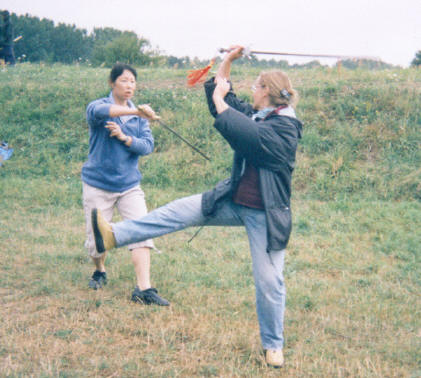
A typical technique from the forms of Wudang sword of Fuzhensong:
Fanshen pi-jian, overturning to the back with the cutting-down sword .
Back to the
HOMEPAGE
|